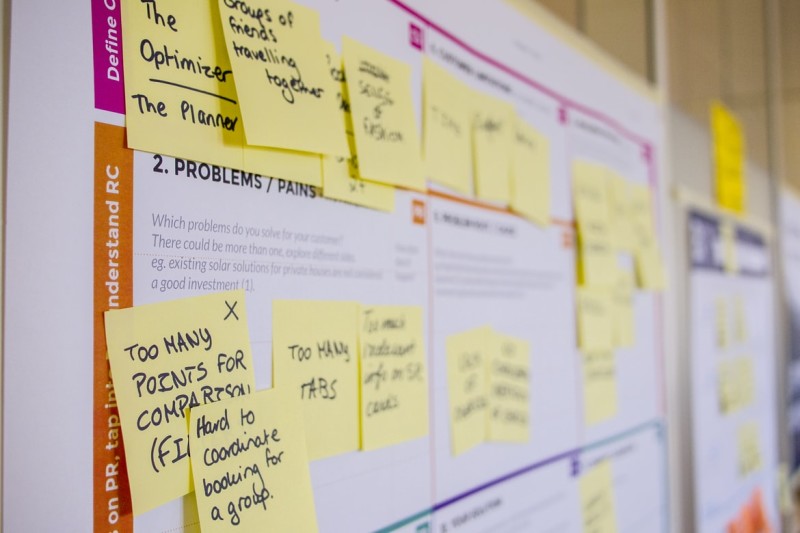There are many methods that can be used to uncover problems. These methods include dogfooding products and industry reports. However, one of the most effective methods is via customer feedback.
Positive or negative, any information that customers provide about your product is considered feedback.
Along with informing you how they feel, customer feedback helps you uncover new problems to tackle. Problems which may then be prioritized and solutions added to your roadmap.
Solving the right problems for your customers is what leads to features and functionality that allows them to reach their goals and continue paying for, and supporting, your solution(s) and business.
Customer feedback comes from various methods, methods which are employed at different times and can also be mixed and matched with one another for deeper insights.

For example sending customer surveys followed by in-person interviews to dig deeper into answers provided. Or analyzing product metrics followed by performing usability tests.
While many product leaders would love to receive positive customer feedback, negative feedback also helps clarify the problems that need to be addressed.
When customers reach out to your customer support team about a bug it’s clear what their issue is, they’ll state it explicitly. And after digging deeper you can work with your team to prioritize the fix.
Here are 2 valuable feedback methods that you can use to uncover problems via customer feedback.
Uncovering problems via customer discovery
One way to uncover problems customers are facing is with discovery calls.
This is where you reach out to your customers to have an open and friendly discussion. The goal of these sessions is to understand their sentiments about your product while also learning about any unmet challenges that they are facing.
This can be a great method to use post release of a new feature for example. Select a few of your customers to speak with and in your discovery call ask open ended questions. These questions will give your customers a chance to share their detailed thoughts and feelings in their own words.
You can draft your own questions, but consider the following:
We released this feature to solve (problem), how has your experience been since launch?
How would you rate this feature from 1 - 5? (apply a scale)
How much more efficient has this new capability made your team?
What key challenges, if any, have you faced with this feature?
Which problems are we not addressing?
Do you have any further thoughts?
This is a great way to uncover unmet needs that customers have.
When customers mention specific points that you find interesting then dig deeper; ask further questions to uncover more.
Employ the “5 whys” technique to get to the root of customer problems. This technique involves asking why multiple times to get to the underlying reason why they are making a request.
I have had many situations where customers have asked for a specific functionality however upon diving deeper realized the specific reason they needed it and was able to deliver the right solution.
It’s also beneficial to quantify the issues that they mention when applicable. When a customer mentions that a process takes “too long” for example, find out how much time is considered too long.
As you build a solution you can test and confirm that it is meeting the target(s) that customers have set.

Uncovering customer problems via usability tests
Another method that can be used to uncover problems via customer feedback are usability tests.
Usability testing involves meeting with customers and watching them interact with your product as they complete defined tasks. Do note that this does not have to be done with a complete product, usability testing can be performed with paper wireframes or a design prototype.
Usability testing is beneficial for understanding whether your customers and users can navigate through your product to accomplish key tasks and understand their overall experience. Even testing with 5 users can uncover 85% of problems.
To perform usability tests start by filtering out your audience; determine which customers and users you want to interview.
The next step is to define the tasks and scenarios you want to complete.
Here is where you use both open-ended and closed-ended questions and tasks.
With open-ended questions there is no limit related to the answer that participants provide. These tasks allow participants to choose how they will accomplish tasks.
Close-ended questions on the other hand are the opposite, there is a defined range of answers that can be provided, the answer options are limited. These task scenarios are used to confirm whether the participants can accomplish the task or not (yes/no).
For example, here are a few questions that participants can be asked as they test your product:
Can you tell me why did (action)?
What was your initial expectation when you (action)?
Was (action) easy or difficult?
While doing (action) I heard you say (repeat statement), please tell me more
Did this experience match similar experiences that you have had with other products?
What did you think of (feature/screen within the product)?

While performing usability tests ask participants to narrate their thoughts audibly as they complete tasks. Doing this helps you understand how they are feeling, why they are making particular decisions, and will give you direct feedback on improvements to make.
As you perform these tests with customers, if you notice that there are particular parts of your product that are misunderstood, causing friction, receiving the most negative feedback, then this is direct feedback from your customers on which problems to solve.
A gift for you to indicate that you need to go back to the drawing board and modify your product. Again, based on customer feedback
Be sure to document this feedback as well so that you can not only refer to it in the future, but share it with other team members as well.
As a product person it’s your job to find and solve problems based on customer feedback, these are just two of many methods that you can employ.
Let the feedback sessions begin!

Quadri Oshibotu

Read also
All product feedback in one place





